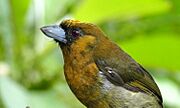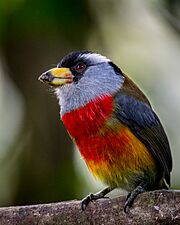Semnornis facts for kids
Quick facts for kids Toucan-barbets |
|
|---|---|
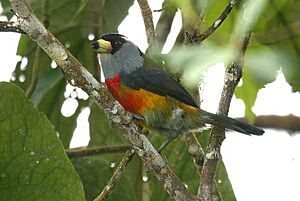 |
|
| Toucan barbet (Semnornis ramphastinus) | |
| Scientific classification |
|
| Kingdom: | Animalia |
| Phylum: | Chordata |
| Class: | Aves |
| Order: | Piciformes |
| Suborder: | Pici |
| Infraorder: | Ramphastides |
| Family: | Semnornithidae Prum, 1988 |
| Genus: | Semnornis Richmond, 1900 |
| Species | |
| Synonyms | |
|
Pan (preoccupied) |
|
Toucan-barbets are a group of small, colorful birds. They belong to the genus Semnornis. There are only two types, or species, of toucan-barbets: the toucan barbet and the prong-billed barbet.
These birds were once thought to be part of a larger group called "barbets." But now, scientists usually put them in their own special family called Semnornithidae. This shows how unique toucan-barbets are! Some scientists even think all barbets might be related to toucans.
Contents
What Are Toucan-Barbets?
Toucan-barbets are fairly large birds for their group. They usually measure between 18 and 21 centimeters (about 7 to 8 inches) long. The toucan barbet is a bit bigger and heavier than the prong-billed barbet.
One cool thing about them is their large, puffy bills. These bills look a bit like those of toucans! Both male and female toucan-barbets look very similar. They don't have big differences in their feather colors.
The prong-billed barbet has feathers that are mostly orange-brown. The toucan barbet is more colorful. Its feathers have clear patterns of black, red, gray, and gold.
Where Do They Live?
Toucan-barbets live in a part of the world called the Neotropics. This area includes Central and South America.
The prong-billed barbet lives only in the wet, high-up forests of Costa Rica and Panama. The toucan barbet lives in similar mountain forests. You can find them in western Ecuador and Colombia.
These birds like to live in untouched forests. But they can also be found at the edges of forests and in areas where new trees are growing. Toucan-barbets do not migrate, meaning they don't fly long distances for seasons. Young birds also tend to stay close to where they were born. For example, young toucan barbets only move about half a kilometer (0.3 miles) away.
How They Live Their Lives
Toucan-barbets are very social birds. You might see them in small groups of up to five or six birds. Sometimes, you'll see them alone. They are active during the day and wake up early.
Prong-billed barbets sleep together in shared roosts at night. They do this when it's not breeding season. As many as 19 birds might sleep in one hole! This hole is often a changed nest or an old nest made by a woodpecker. During the breeding season, pairs of birds sleep in their own nests.
What Toucan-Barbets Eat
These two species eat both fruits and insects. They eat more fruit than other types of barbets. In fact, a study from 1993 found only fruit in their stomachs!
They can eat fruits whole. Sometimes, they hold the fruit with their foot and break it apart. They might also crush the fruit and only drink the juices.
Insects are more important for baby birds. About 40% of the food brought to toucan-barbet nests is insects. Toucan-barbets might even feed their chicks a few small vertebrates (animals with backbones). They have also been seen eating flowers!
Reproduction and Raising Young
Both types of toucan-barbets are monogamous. This means they have only one partner for breeding.
Prong-billed barbets protect their breeding areas from other birds of their species. Toucan barbets also have their own areas. But they get help from other birds to raise their young. These "helpers" are often older offspring from previous years.
Toucan-Barbet Species
| Common name | Scientific name and subspecies | Range | Size and ecology | IUCN status and estimated population |
|---|---|---|---|---|
| Prong-billed barbet | Semnornis frantzii (Sclater, PL, 1864) |
Costa Rica and western Panama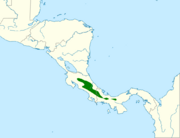 |
Size: Habitat: Diet: |
LC
|
| Toucan barbet | Semnornis ramphastinus (Jardine, 1855) |
western Ecuador and Colombia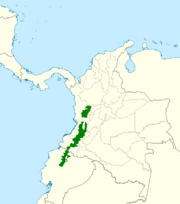 |
Size: Habitat: Diet: |
NT
|


